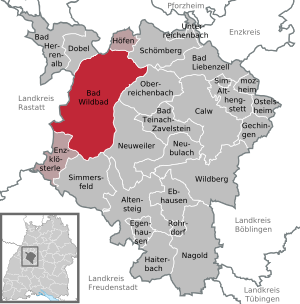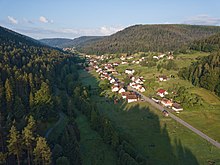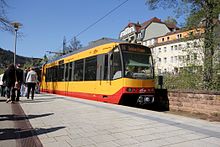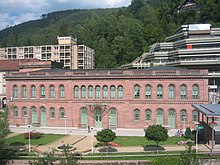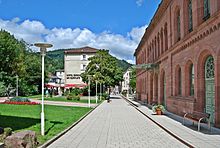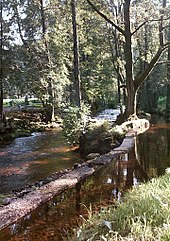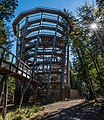Bad Wildbad
| coat of arms | Germany map | |
|---|---|---|
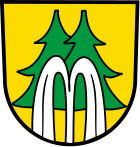
|
Coordinates: 48 ° 45 ' N , 8 ° 33' E |
|
| Basic data | ||
| State : | Baden-Württemberg | |
| Administrative region : | Karlsruhe | |
| County : | Calw | |
| Height : | 425 m above sea level NHN | |
| Area : | 105.27 km 2 | |
| Residents: | 10.130 (Dec. 31, 2018) | |
| Population density : | 96 inhabitants per km 2 | |
| Postal code : | 75323 | |
| Primaries : | 07081, 07085, 07055 | |
| License plate : | CW | |
| Community key : | 08 2 35 079 | |
| LOCODE : | DE BWB | |
| City structure: | 6 districts | |
City administration address : |
Kernerstraße 11 75323 Bad Wildbad |
|
| Website : | ||
| Mayor : | Klaus Mack ( CDU ) | |
| Location of the city of Bad Wildbad in the Calw district | ||
Bad Wildbad (until 1990 Wildbad in the Black Forest ) is a spa town in the Calw district in Baden-Württemberg . It belongs to the Northern Black Forest region .
geography
Geographical location
Bad Wildbad is located in the valley of the Enz , a tributary of the Neckar . In the district of Calmbach the two source rivers Kleine Enz and Große Enz merge to form the actual Enz.
Neighboring communities are Höfen an der Enz in the north and Enzklösterle in the south .
City structure
The city of Bad Wildbad consists of the former communities of Aichelberg, Calmbach and Wildbad in the Black Forest. The former municipality of Aichelberg (municipality of Bergorte) includes the village of Aichelberg, the villages of Hünerberg, Meistern and the Aichelberger Sägmühle, "Kälbermühle, Pumpwerk" and Rehmühle. The village of Calmbach and Tannmühle belong to the former municipality of Calmbach. The former municipality of Wildbad in the Black Forest in 1973 includes the core town, the hamlets of Christophshof, Nonnenmiß and Sprollenhaus, the villages of Grünhütte, Kälbermühle, Kleinenzhof, Lautenhof, Sommerberg, the Kohlhäusle homestead and the Rollwasser and Sprollenmühle houses.
The Hochwiese and Ziegelhütte residential areas in the former municipality of Wildbad in the Black Forest were closed on August 17, 1970.
climate
Because of its special valley location, the amount of sunshine a day is on average two hours shorter than in the surrounding communities. The average temperature is therefore around 1 ° C lower than in other Black Forest locations that are at the same altitude ( 424 m above sea level ). However, this does not apply to the summer mountain and the mountain resorts of Aichelberg, Hünerberg and Meistern in the south, which are on the mountain at 700 to 800 m above sea level. NN lie. Here, when the weather is nice, as in other places on the mountain heights, beautiful play of colors can be observed during the sunrises and sunsets in the sky.
history
History of Wildbad
A Wiltbade was first mentioned in a document in 1345. In it, the castle and town of Zavelstein were pledged to the Count Palatine of Tübingen "ane das Wiltbade das Hant Sie In behabet" . In 1367, Count Eberhard II of Württemberg (also called Greiner), who was swimming with his family in the wild, was attacked by the Martinsvögel . He was only able to escape and save himself to his castle Zavelstein. In Ludwig Uhland's poem, this episode is depicted heroically. However, these mentions are uncertain because they can also refer to Bad Teinach .
However, it is certain that Wildbad already existed in the early Middle Ages . This is also indicated by the original source discovered in 1904. The vessels and pieces of oak found there were dated to the 12th century in radiocarbon and dendrochronological studies.
The first reliable mention of Wildbad is from 1376, when the Bishop of Speyer was asked to authorize the Wildbad chaplain to carry out baptisms and funerals himself and to receive bequests and tithes. Wildbad was surrounded by a wall for protection and made an official city in 1442. In the 15th century, Wildbad appeared as an important bathing resort. Many noble and high-ranking guests sought cure for their ailments in the thermal baths .
During the peasant uprising in 1525, for example, there were many knights and some princes and abbots in Wildbad. Their hostels were hung with flags, coats of arms and shields, which allowed the fire to spread quickly during the great city fire. During this time Wildbad was one of the strongholds of bismuth painting . The noble guests gladly took the boxes painted on the bismuth base with them as souvenirs . Even a winged altar for Abbess Veus is said to have been made there in 1551. As early as 1514, there was an urban order of painters , lathe operators and shopkeepers in Wildbad .
The letter of freedom drawn up by Emperor Maximilian I , which burned in 1525, was renewed by Emperor Charles V in 1530 .
Up until the Reformation , the Wildbad parish belonged to the Weil district of the city in the Archdiaconate Trinity of the Diocese of Speyer .
Over the centuries, Wildbad enjoyed a stormy upswing, thanks to support from the Counts, Dukes and Kings of Württemberg . Modern bathing buildings, the Ducal Palace , the spa facilities as well as modern hotels and inns were built to accommodate the steadily growing number of bathers. Interrupted by wars and city fires, the ducal, later royal bath was repeatedly rebuilt and modernized.
The Wildbad Office came to the Oberamt Neuenbürg in 1807 when the new administrative structure in the Kingdom of Württemberg was implemented . With the district reform during the Nazi era in Württemberg , Wildbad came to the district of Calw in 1938.
On January 12, 1945, the Reichsführer SS Heinrich Himmler and the former Swiss President Jean-Marie Musy met in the Wildbader Hotel Post and negotiated the release of Jewish concentration camp prisoners. The Nazi state wanted to get foreign currency or military equipment in this way.
After the Second World War, Wildbad fell into the French zone of occupation and thus came to the newly founded state of Württemberg-Hohenzollern in 1947 . In 1952, the provisional post-war state was added to the administrative district of Südwürttemberg-Hohenzollern and has since been part of the new federal state of Baden-Württemberg. With the district reform on January 1, 1973 , the district of Calw reached its present size. The district also became part of the newly founded Northern Black Forest region , which was assigned to the then newly circumscribed administrative district of Karlsruhe . The former Württemberg city of Bad Wildbad is now also administered from the former Baden capital Karlsruhe.
History of the districts
Calmbach
The place is mentioned for the first time in 830 as Calenbach in the Codex Hirsaugiensis , since the Hirsau Monastery was wealthy here in the 9th century . Calmbach is mentioned very clearly in 1100, when a Countess Richlind from Calw donated six Huben and six serfs "ad Calenbach" to the Hirsau monastery . In the 14th century the place was owned by the Counts of Vaihingen . Together with Neuenbürg , Calmbach came to the county of Württemberg.
The main source of income for the residents was rafting and forestry. Agriculture was insignificant. Daring timber merchants (also known as boatmen) brought it to wealth and prosperity, while the inhabitants lived a meager existence.
With the rating of climatic health resort , tourism began as an additional source of income in the 1930s. Today the district, which is also known as the five-valley town, is a residential community with a good infrastructure.
At the beginning of the 1950s there was a large tented holiday camp run by the Free German Youth (FDJ). Since 2005 Calmbach has housed more than 5000 residents.
Sprollenhaus and Nonnenmiß
The first documentary mention is a settlement of the Kegelbachtal, (formerly Mühlbachtal) with a sawmill in 1528. Around 1560 a forester's house is built in the "Spolenwaser-Hut". In 1594 and 1624 the small settlement appears in a document under "Spollenhauß".
Around 1763 Sprollenhaus became larger due to the settlement of colonists who cleared the forest to gain arable land and earned their living as wood chippers. Today Sprollenhaus and Nonnenmiß are residential communities.
The district of Nonnenmiß has always been divided into two parts: the larger northern part belongs to Bad Wildbad, the area south of the Dietersbach belongs to the municipality of Enzklösterle . There is insufficient evidence that there was a women's convent in the area from which Nonnenmiß got its name. It is assumed that the place name means "damp swampy meadow (so-called" Miss "), on which there are cut female pigs (so-called" nuns ")".
Aichelberg, Hünerberg, Meistern and Rehmühle (former municipality of Bergorte)
The mountain village was first mentioned around 1330 as "Villula Aychelberc". The local lords at that time were the lords of Fautsberg and their heirs, the lords of Horneck von Hornberg . They sold half of the castle and the associated places to Württemberg, the other half was sold to Württemberg by the Count Palatine of Tübingen in 1345 . In addition, it may be mentioned that the name Hünerberg comes from Auerhanborg.
It is also of local historical interest that in a document dated April 22, 1561, the Württemberg reformer Johannes Brenz received the Fautsburg (Vogtsburg) from the Württemberg duke as a fief. In addition to meadows and fields, the fiefdom also included wood and water justice and the Fautsberger saw mill (Aichelberger saw mill).
The villages of Aichelberg, Meistern, Hünerberg, Kälbermühle and Rehmühle formed the Bergorte community in 1850. Before that, they belonged to the Neuweiler staff for centuries as part of the Vogtsberg rule, a sub-office of the Calw bailiwick. In 1938 the community was named Aichelberg. Against the background of the state-wide municipal area reform taking place in Baden-Württemberg from 1972, the Aichelberg municipal council decided in 1973 to apply for incorporation into the neighboring municipality of Simmersfeld. As part of a "citizens' initiative" on November 11, 1973, a majority of the citizens decided to merge with Wildbad (today's Bad Wildbad). So that in 1974 it was voluntarily incorporated into Wildbad in the Black Forest.
In the past, the inhabitants lived mainly from agriculture and forestry. The beautifully situated district is now a residential community with main and part-time agricultural businesses as well as handicrafts and restaurants. Moderate tourism has taken on an important role. Inaugurated in 2008 Fautsburg Rundwanderweg / historic circular trail Fautsburg presents the history of the mountain towns and the region vividly in beautiful nature is. Every year, held on 24 December, the Forest Christmas with living nativity scene near the forest of Aichelberg instead.
Spatial development of the urban area
On January 1, 1974, Aichelberg was incorporated into Wildbad in the Black Forest on the basis of a public petition. The city was newly formed on July 1, 1974 through the merger of Wildbad in the Black Forest with the municipality of Calmbach. It has been called Bad Wildbad since 1990 .
Religions
Wildbad has been evangelical since the Reformation , but today there is again a Roman Catholic community in the city. In addition to the two major denominations, the Liebenzeller Community Association now also has its own congregation in Calmbach, an Adventist , an Evangelical Methodist and a New Apostolic congregation as well as Jehovah's Witnesses .
There was no Jewish community. The activities of Jewish doctors and restaurateurs at the beginning of the twentieth century are well documented. Several people died in concentration camps in 1942 . The Bad Wildbad hotelier Aurel Radowitz had to move to the neighboring Enzklösterle in 1941. He was deported from Enzklösterle in 1942 and died on November 5, 1942 in Auschwitz.
Population development
Since 2000, Wildbad has had a negative population development due to young people moving to university towns and taking up work.
The population decline between 2001 and 2010 was approx. 7%. The average age increased from 43.0 to 46.3 years in the same period.
The population forecast up to 2035 is significantly below the national average with a growth of 2.1%.
| year | 1961
(Census) |
1970
(Census) |
1975 | 1980 | 1985 | 1987
(Census) |
1990 | 1995 | 2000 | 2005 | 2010 | 2011
(Census) |
|---|---|---|---|---|---|---|---|---|---|---|---|---|
| population | 11022 | 12324 | 11611 | 10994 | 10472 | 10133 | 11587 | 11667 | 11214 | 11055 | 10521 | 9632 |
| year | 2011 | 2012 | 2013 | 2014 | 2015 | 2016 | 2017 | 2018 | 2019 |
|---|---|---|---|---|---|---|---|---|---|
| population | 9537 | 9542 | 9565 | 9637 | 9876 | 9849 | 10,083 | 10.130 | 10,202 |
| source |
politics
Bundestag election
The last federal election was held in 2017 and led to the following final result:
| Parties | %
2017 |
%
2013 |
%
2009 |
%
2005 |
%
2002 |
%
1998 |
|
|---|---|---|---|---|---|---|---|
| CDU | Christian Democratic Union of Germany | 36.8 | 49.0 | 35.5 | 39.2 | 45.8 | 37.5 |
| Green | GREEN | 9.5 | 6.8 | 8.4 | 7.9 | 8.5 | 5.9 |
| SPD | Social Democratic Party of Germany | 16.0 | 19.1 | 19.3 | 29.5 | 31.7 | 35.0 |
| FDP | Free Democratic Party | 13.0 | 8.4 | 22.1 | 14.1 | 9.0 | 13.5 |
| AfD | Alternative for Germany | 15.1 | 5.4 | - | - | - | - |
| Left / PDS | Die Linke / PDS | 5.4 | 4.7 | 8.3 | 4.1 | 1.0 | 0.9 |
| Other parties | 4.2 | 6.6 | 6.4 | 5.2 | 4.0 | 7.2 | |
| total | 100 | 100 | 100 | 100 | 100 | 100 | |
| voter turnout | 73.0% | 70.4% | 69.8% | 76.5% | 78.4% | 82.0% | |
State elections
The last state election was held in 2016 and led to the following final result:
| Parties | %
2016 |
%
2011 |
%
2006 |
%
2001 |
|
|---|---|---|---|---|---|
| CDU | Christian Democratic Union of Germany | 33.7 | 45.8 | 44.5 | |
| Green | GREEN | 22.3 | 16.1 | 4.0 | |
| SPD | Social Democratic Party of Germany | 11.1 | 21.7 | 32.2 | |
| FDP | Free Democratic Party | 9.4 | 7.4 | 12.1 | |
| AfD | Alternative for Germany | 18.6 | - | - | |
| total | 95.1 | 91.0 | 92.8 | ||
| voter turnout | 65.8% | 60.8% | 60.0% | ||
Municipal council
In Bad Wildbad, the municipal council is elected using the spurious selection process . The number of local councils can change due to overhang mandates . The municipal council consists of the elected voluntary councilors and the mayor as chairman. The mayor is entitled to vote in the municipal council. The local elections on May 26, 2019 led to the following preliminary final result.
| Parties and constituencies |
% 2019 |
Seats 2019 |
% 2014 |
Seats 2014 |
%
2009 |
Seats
2009 |
%
2004 |
Seats
2004 |
%
1999 |
Seats
1999 |
||
| CDU | Christian Democratic Union of Germany | 41.09 | 9 | 44.5 | 10 | 36.3 | 8th | 33.0 | 7th | 27.9 | 7th | |
| SPD | Social Democratic Party of Germany | 30.55 | 6th | 28.5 | 6th | 25.0 | 5 | 26.8 | 5 | 18.8 | 4th | |
| Green | GREEN | - | - | - | - | - | - | - | - | 4.4 | 1 | |
| FWV / FDP | Free Electoral Association / Free Democratic Party | 28.36 | 6th | 27.0 | 6th | 18.3 | 4th | 14.9 | 3 | 23.0 | 5 | |
| Voters' associations, individual applicants | - | - | - | - | 20.4 | 4th | 25.3 | 5 | 25.8 | 6th | ||
| total | 100.0 | 21st | 100.0 | 22nd | 100.0 | 21st | 100.0 | 20th | 100.0 | 23 | ||
| voter turnout | 50.38% | 46.0% | 47.3% | 48.1% | 53.8% | |||||||
Mayor Wildbad / Bad Wildbad
- 1847–1878: Hermann Mittler
- 1878–1905: Heinrich Baetzner
- 1905–1933: Carl Baetzner
- 1933–1945 and 1949–1959: Paul Kießling
- 1960–1974: Hermann Saam ( FDP / DVP )
- 1974–1990: Ulrich Maier
- 1990–1998: Bodo König ( SPD )
- 1998–2006: Walter Jocher (independent)
- since 2006: Klaus Mack ( CDU )
Mack was re-elected in 2014 with almost 96% and, according to the Black Forest Messenger, had no serious opponent. The turnout was 29%.
coat of arms
The town of Wildbad in the Black Forest, which emerged from the municipal reform in 1974, was given a new coat of arms on August 11, 1981 : “Two green fir trees in gold, the left of which partially covers the right, both covered up to the middle by one rising from the lower edge and in two rays falling silver fountain. "
The coat of arms of the mountain villages or Aichelberg shows a golden oak branch on a blue background.
Town twinning and church partnerships
Since 1981 there has been a partnership with the municipality of Cogolin in the Var département in southern France . School exchanges took place regularly beforehand . The Aichelberg Protestant parish, together with the Stammheim Protestant parish and the Zwerenberg Protestant parish, has a partnership with the parish in Triptis, Thuringia .
Economy and Infrastructure
Commercial enterprise
Wildbad's economy consists primarily of the health and tourism sectors. Since 1984 the number of tourism businesses has fallen by over two thirds. Of the previous 105 tourism businesses, 34 have remained.
The occupancy rate of these hotels and guest houses has also decreased from well over 40% to only 27%. The city is undergoing structural change from a health resort to a tourist city.
The Alfred Gauthier GmbH manufactured machine tools and camera shutters. In 1959 it employed 3,200 people. During the Second World War, Alfred Gauthier GmbH played a key role in the millions of automated production of grenade detonators. In 2020, it still employed just over 300 people and had to file for bankruptcy in the wake of the corona crisis.
With Berthold Technologies there is a provider of process measurement technology, radiation protection and bioanalytics.
There is also a regional office of the Black Forest Bote in Wildbad.
traffic
Bad Wildbad through line S 6 of the rail Karlsruhe , by the Albtal-transport company is operated, connected to the rail network. The light rail runs on the Enz Valley Railway to Pforzheim and is partially connected as the S 5 to Karlsruhe / Wörth am Rhein and until 2019 also to Bietigheim-Bissingen . In the urban area there are the stops Kurpark, Uhlandplatz / Sommerbergbahn, Bad Wildbad Bahnhof, Bad Wildbad Nord, Calmbach Süd and Calmbach Bahnhof. On Sundays and public holidays, from 1 May to mid-October, the Enztäler Radexpress excursion train runs twice in each direction from Stuttgart via Ludwigsburg, Bietigheim-Bissingen, Vaihingen / Enz, Mühlacker, Pforzheim and Neuenbürg to Bad Wildbad Bahnhof.
Summer mountain railway
The summer mountain railway leads up to Wildbad's local mountain and overcomes an altitude difference of around 300 meters.
Master tunnel
The Meisterntunnel was built in 1996 to relieve traffic in Bad Wildbad. The 1,684 m long single-tube tunnel is part of the state road 351 . Work on the construction of an escape tunnel began in January 2015 and has now been completed.
Enztal cycle path
The Enztal cycle path is a 100 km long cycle path and leads through Bad Wildbad. It runs along the Enz from its source at Enzklösterle to its confluence with the Neckar at Walheim .
Spa facilities
Wildbad has been known as a health resort since the 15th century. The townscape is mainly characterized by outstanding examples of spa architecture from the 19th and early 20th centuries.
- Palais Thermal , built in 1847 as Graf-Eberhard-Bad (princely baths , Moorish hall, modern extensions)
- Vital Therme (formerly thermal movement bath) with indoor and outdoor pools, sauna area and sunbathing lawn
- Sana Kliniken Bad Wildbad with the departments of orthopedics , rheumatology and internal medicine as well as the neurological rehabilitation center Quellenhof
- Forum König-Karls-Bad as a guest house with lecture, reading and event rooms
- Kurhaus with Kursaal for concerts and dance events
- Royal Spa Theater , reopened in July 2014 after years of renovation
The spa park was laid out in 1699 and has been expanded again and again since then. The extensive network of trails extends around 1.5 km on both sides of the Enz.
Educational institutions
Bad Wildbad has all conventional school forms. The Abitur can be taken at the Enztal Gymnasium . The Fünf-Täler-Schule in Calmbach (formerly Goßweilerschule or Realschule Calmbach) bundles the school forms of elementary, technical and secondary school . The suburb of Aichelberg with the mountain resorts of Aichelberg, Hünerberg, Meistern and Rehmühle is supplied with primary school technology by the Simmersfeld School Association. The school association consists of the community of Simmersfeld and the city of Bad Wildbad. It still exists from the time when the Bergorte were first as the municipality of Bergorte and later as the municipality of Aichelberg. The Wilhelmschule in Bad Wildbad is a two-tier elementary school. There is also the Upper Enztal Elementary School Association for the Sprollenhaus and Nonnenmiß sub-locations (together with the Enzklösterle community) and the Goßweiler Förderschule Calmbach.
In the building of the spa clinic, which was closed in 2004, Bad Wildbad has also had one of three locations of the state academy for advanced training and personnel development at schools in the state of Baden-Württemberg since 2007 . At the Bad Wildbad location, the training courses for general education schools and special schools take place.
Leisure and sports facilities
- In August 2018, the WildLine pedestrian suspension bridge was opened on the Sommerberg not far from the treetop path . It is located on the Märchenweg between Auchhalder-Kopf-Hütte and Heermannsweg, is 380 meters long and is up to 60 meters above ground. Those responsible expect around 100,000 visitors per year.
- On September 26, 2014, the Black Forest Treetop Walk was opened on the Sommerberg . It is 1250 m long, up to 20 m high and has a 38.5 m high observation tower, inside of which there is a 55 m long tunnel slide. Due to its barrier-free and step-free structure, it is suitable for wheelchair users and prams. 200,000 visitors are expected each year.
- Ski lifts and ski touring trails - the ski trails on the Sommerberg, the mountain forest trail and the sun trail on the Aichelberg are particularly beautiful. There are ski lifts on the Sommerberg, in Kaltenbronn and Enzklösterle.
- Nordic walking routes in the spa park
- Bad Wildbad's local mountain, the summer mountain, has been an attraction for mountain bikers since August 2000. The topography of the summer mountain, the mountain railway and the two ski lifts offer good conditions for fans of Biker-X, dual slalom, freeride or downhill routes. The Downhill 1 route in Bad Wildbad is one of the most demanding downhill routes in Germany. In April 2019, the Federal Court of Justice and the Higher Regional Court of Stuttgart decided the process between the city and the operator of the downhill route over the transport of bikers in favor of Wildbad. A conceptual realignment is planned from 2021.
- Calmbach forest swimming pool
- The indoor pool was closed. A demolition is planned.
Energy generation and use
According to Klaus Mack's announcement at the end of October 2019, the construction of the “Kälbling” wind farm should begin by the end of 2020 at the latest. The three planned wind turbines should cover around 60% of Wildbad's electricity requirements. EnBW is the developer and project manager .
There are also five e-charging stations in the city.
In 1906, the city of Bad Wildbad built a hydropower plant next to König-Karl-Straße on the spot where a sawmill previously used the river water. In 1997 the two turbines were overhauled and the generators replaced with new technology.
Debt situation
Bad Wildbad's debts per inhabitant are above average despite the economic upswing and have been rising continuously since 2010. The tax revenues from the economic upswing could not be used.
| year | Core budget | Own operations | total | Debt per inhabitant |
|---|---|---|---|---|
| 2000 | 15,061,000 | 10,093,000 | 25,154,000 | 2,252 |
| 2005 | 9,140,000 | 15,272,000 | 24,412,000 | 2,192 |
| 2010 | 8,895,000 | 10,126,000 | 19,020,000 | 1,803 |
| 2015 | 13,096,000 | 11,065,000 | 24,161,000 | 2,469 |
| 2016 | 13,598,000 | 10,568,000 | 24,166,000 | 2,447 |
| 2017 | 14,851,000 | 10,843,000 | 25,694,000 | 2,595 |
| 2018 | 14,983,000 | 11,622,000 | 26,605,000 | 2,638 |
| 2019 | 14,815,000 | 12,193,000 | 27,008,000 | 2,665 |
Culture and sights
Regular events
- Performances of the annual Rossini opera and concert festival in Wildbad
- Every year in summer the Enzanlage lighting takes place with brilliant fireworks
- Bad Wildbad is the venue for the annual iXS German Downhill Cup (last time in 2014)
- Winter magic in the Kurpark - the Christmas market always takes place on the first weekend in December
- Aichelberg Forest Christmas with a living nativity scene with Joseph, Mary, baby Jesus, shepherds, angels, donkeys and sheep - always on December 24th. at 4 p.m.
- If there is enough snow, the traditional barrel stave race takes place on the Sommerberg in winter. The slightly curved barrel staves with strap bindings once served as a replacement for skis.
Local literature
- Bad Wildbad crime novels:
- "Schmälzle and the herbs of death" by Linda Graze
- “Swabian Dreams” by Klaus Wanninger
- A novel based on a historical event with a local reference:
- "Berry Summer" by Inge Barth-Grözinger
- Historical elaboration:
- "The Grail Trail from Calw" by Hans Georg Heide
Wildbad is the setting for the first chapters of the novel "Armadale" by Wilkie Collins (1866).
Museums
There is a local history and rafting museum in the Calmbach district.
In the Aichelberg district, the Gottscheer Stube is in memory of a German-speaking community that was driven from their homeland in the area of former Yugoslavia due to the aftermath of the world wars. A room with exhibits commemorating the culture and history of this ethnic group.
Buildings & special small monuments


- Evangelical town church (1746)
- Palais Thermal (1840–47), then a large bath building
- The former Royal Spa Theater was built in 1865. Extensive renovations began in 2000 and ended with the reopening on July 1, 2005 during the 17th International Rossini Festival. The Kurtheater was named Monument of the Month for October 2007 by the Baden-Württemberg Monument Foundation. After many years of renovation, it reopened on July 10, 2014 with the concert performance of the Rossini opera Il viaggio a Reims .
- English Church (1865)
- Moorish pavilion (1875)
- Catholic Church of St. Boniface (1877)
- The König-Karls-Bad (today Forum König-Karls-Bad) was built in two construction phases in 1881–1892.
- Garden hall (1900)
- The new drinking hall was built in 1933/1934. Today it is used as a cultural center pump room for events.
- Treetop Walk Black Forest
- Wildline - suspension bridge (2018)
- Aichelberg Art Nouveau Church (1907)
- Fautsburg ruins from the 12th century
- The Baden-Württemberg border stone in Aichelberg (15th / 16th century). From 1397 to 1603 part of the Altensteig parish, to which Simmersfeld also belonged, was in Baden. The boundary between Aichelberg and Simmersfeld formed the border between Baden and Württemberg at that time. The boundary stone in the place today, which contains both Baden and Württemberg coats of arms, cannot have been there at any time. Probably this was moved in the middle of the place. But today there is a beautiful small memorial for the former Baden-Württemberg border history. Today's smugglers' trail is also a reminder of this time on the border with Simmersfeld in the forest.
Well-known personalities in Wildbad are Ludwig Hofacker , the spa doctors from Renz and Justinus Kerner , and the Württemberg author, politician (Paulskirche) and translator (Aristophanes) Ludwig Seeger was born in Wildbad . The royal court photographer Karl Blumenthal is also known far beyond the borders of Wildbad with his pictures of the old forest professions.
Karl Wilhelm Bauerle (English: Bowerley), * 1831 in Endersbach (today in Weinstadt ), † 1912 in Aichelberg (Black Forest; today in Bad Wildbad), was a painter in London, since 1869 at the court of Victoria, Queen of Great Britain and Ireland, since 1876 as an English citizen. He moved to Germany out of anger about the British war against the Boers .
The Germanist and literary scholar Werner Keller (1930–2018) was born in Calmbach, he was a university professor and honorary president of the Goethe Society.
Georg Sick , a Pour le Mérite bearer, died here in 1937. The order was the highest distinction of the Kingdom of Prussia during the First World War .
The Holocaust denier Ernst Zündel (1939–2017) was born in Calmbach and grew up here. In 2005 he was expelled from Canada after a long stay on the North American mainland and extradited to Germany. After his release from prison in 2010, Zündel lived again in Calmbach and died there in 2017.
The tennis player Marcello Craca grew up in Bad Wildbad.
The economist and financial scientist Rudolf Hickel , * 1942 in Nuremberg, grew up in Bad Wildbad.
People who found refuge in Bad Wildbad-Aichelberg:
- Count Hans von Helfenstein was cathedral dean of Strasbourg, as a church critic he had to flee. In 1476 he found refuge in the Fautsburg in the mountain villages near Aichelberg and Hünerberg.
- Johann Valentin Andreae found refuge in Neuweiler with the pastor's family there in the 1630s during the Thirty Years' War when he was fleeing Calw. In Neuweiler you can still find the inscriptions of one of his children who died in Neuweiler and was buried there on a tombstone by the church in the churchyard there. When Andreae was no longer safe in Neuweiler either, he fled to Aichelberg and was able to flee from the army of the Catholic Emperor there. As a punishment, however, the richest farmer from Aichelberg, along with his farm and family, was burned.
- Johannes Brenz, the famous Württemberg reformer, received the Fautsburg from 1561 to 1570 from the Duke of Württemberg as a fief.
Persons related to Bad Wildbad:
- Duke Karl Alexander signed a contract (letter of protection) with the Jewish merchant Joseph Süsskind Oppenheimer . This is what the anti-Semitic film Jud Suss is based on .
literature
- Ernst Ammer u. a .: The Wildbad in the Black Forest , District History Association Calw eV, Bad Wildbad 2017; ISBN 978-3-86595-529-6 .
- Fritz Barth: How it was back then - people, episodes and traditional things from the Upper Enz Valley and beyond . Self-published by Fritz Barth, Bad Wildbad 2007 Contents
- Fritz Barth: A journey through time between Enz and Nagold. People, episodes and traditional things from Calmbach, Wildbad and far beyond. Then and now . Self-published by Fritz Barth, Bad Wildbad 1999 Contents
- Fritz Barth: Another journey through time. People, episodes and traditional things from Calmbach, Wildbad and far beyond. Then and now . Self-published by Fritz Barth, Bad Wildbad 2001 Contents
- Fritz Barth: Hope War Not - Events and Episodes 1930 to 1950 from the places of the Upper Enz Valley and beyond . Self-published by Fritz Barth, Bad Wildbad 2010 (new edition) Contents
- Carl Maximilian Eifert: News on the history of Calmbach and courtyards . Foundation Care, Calmbach 1850 (reprint, edited and to live data Eiferts increased by Fritz Barth. Selbstverlag * Fritz Barth, Neuenbuerg 1993) Content
- Otto Bach: 600 years of Wildbad in the Black Forest 1367–1967. Reproduced typescript. Wildbad 1967.
- Karl Konrad Finke: The assassination attempt on Count Eberhard II of Württemberg. The << attack in the Wildbad >> 1367. In: Schwäbische Heimat vol. 67 (2016), Heft 3, pp. 286–294.
- Thomas Eckhard Föhl: Wildbad. The chronicle of a spa town as building history. Druckhaus Müller, Neuenbürg 1988.
- Karl Greiner : Bad Wildbad. Its history from the 12th to the 20th century. 5th edition, revised and supplemented by Siegfried Greiner. Weberdruck, Pforzheim 1995.
- Sabine Holtz: "Heil'ge spring that works a thousand miracles!" Bad Wildbad ; in: W. Niess, S. Lorenz (Ed.): Cult baths and bath culture in Baden-Württemberg ; Markstein-Verlag, Filderstadt 2004, ISBN 3-935129-16-5
- Justinus Kerner: The Wildbad in the Kingdom of Württemberg. In addition to news about the neighboring healing springs Liebenzell and Teinach and the Hirsau monastery . Edited by Uwe Ziegler. Gengenbach Verlag, Bad Liebenzell 1985, ISBN 3-921841-26-7
- Götz Bechtle: “Wildbad from A to Z - interesting, historical, worth knowing - a paperback for wild bath friends” ; Self-published by Götz Bechtle, Bad Wildbad; Drawings by Hans K. Schlegel, 1996
- Götz Bechtle: "Bad Wildbad" - Wildbad water works wonders - the thermal baths have been bubbling for more than seven centuries ; in: The baths in the district of Calw ; ed. v. District History Association Calw e. V., H. Schabert et al. A. pine; Bad Wildbad, 2010; ISBN 978-3-86595-386-5
- Johannes Wilhelm: Bad Wildbad: Urban planning example of a spa town. In: Denkmalpflege in Baden-Württemberg , 25th year 1996, issue 1, pp. 30–38. ( PDF; 10.4 MB )
- District History Association Calw (ed.): The Wildbad in the Black Forest. Bathing and healing for more than 650 years. Geigerdruck, Horb am Neckar 2017. ISBN 978-3-86595-529-6
Web links
- Internet presence of the city of Bad Wildbad
- Local history research Upper Enz Valley and Northern Black Forest Publications by Fritz Barth, including on the history of Bad Wildbad and its suburbs
- The bath book of the master singer and printer Hans Folz with tribute to the medieval medicinal bath
Individual evidence
- ↑ State Statistical Office Baden-Württemberg - Population by nationality and gender on December 31, 2018 (CSV file) ( help on this ).
- ^ The state of Baden-Württemberg. Official description by district and municipality. Volume V: Karlsruhe District Kohlhammer, Stuttgart 1976, ISBN 3-17-002542-2 . Pp. 512-514.
- ↑ Fritz Barth: Hope War Not . Self-published by Fritz Barth, Bad Wildbad 2010, p. 183 .
- ↑ Entry on the homepage of the District History Association Calw e. V.
- ^ Website of the municipality of Enzklösterle: Information on the districts
- ↑ Gregor Swierczyna: From lords, bailiffs , counts and dukes: Development of rule and ownership in the district of Calw up to territorial affiliation with the Kingdom of Württemberg. In: District of Calw (ed.): The district of Calw. A yearbook. Volume 25, 2007, ISBN 978-3-00-022880-3 , p. 189.
- ^ Federal Statistical Office (ed.): Historical municipality directory for the Federal Republic of Germany. Name, border and key number changes in municipalities, counties and administrative districts from May 27, 1970 to December 31, 1982 . W. Kohlhammer, Stuttgart / Mainz 1983, ISBN 3-17-003263-1 , p. 488 .
- ↑ On Jewish footsteps in Bad Wildbad: Art historian gives insights - Region - Pforzheimer-Zeitung. Retrieved November 6, 2019 .
- ↑ Schwarzwälder Bote, Oberndorf Germany: Bad Wildbad: Wildbad Christians commemorate Reichspogromnacht - Black Forest Bote. Retrieved November 6, 2019 .
- ↑ Röhrle, Sebastian., Viehweg, Jeremias., Gote, Fabian., Grimm, Pascal., Schmidt, Kevin .: "We were happy when it was over": the exclusion and persecution of Jews in the Calw district between 1933-1945 . Ed .: Christiane-Herzog-Realschule Nagold. 1st edition 2017. Geigerdruck GmbH, Horb 2017, ISBN 978-3-86595-649-1 .
- ↑ registration card of the municipality Enzklösterle from 17.10.1942 according to written information provided by the Mayor's Office Enzklösterle from 11/11/2019
- ^ Entry in the memorial book for Radowitz, Aurel in the memorial book of the Federal Archives of the Federal Republic of Germany for the victims of persecution of the Jews. Online at www.bundesarchiv.de/gedenkbuch
- ↑ Schwarzwälder Bote, Oberndorf Germany: Bad Wildbad: Ideas developed for the city - Schwarzwälder Bote. Retrieved October 22, 2019 .
- ↑ Average age and age groups by gender - State Statistical Office Baden-Württemberg. Retrieved October 24, 2019 .
- ↑ Dr Matthias Proske: Current challenges for rural areas. (PDF) Northern Black Forest Region Regionalverband, 2018, pp. 5–12 , accessed on November 1, 2019 .
- ↑ Population by nationality - Bad Wildbad. Baden-Württemberg, State Statistical Office, accessed on October 22, 2019 .
- ↑ Bundestag elections since 1998, second votes with postal voters - State Statistical Office Baden-Württemberg. Retrieved November 27, 2019 .
- ^ State elections for voters and votes with postal voters - State Statistical Office of Baden-Württemberg. Retrieved November 22, 2019 .
- ↑ PERSONAL - Klaus Mack. Retrieved October 25, 2019 .
- ↑ Schwarzwälder Bote, Oberndorf Germany: Bad Wildbad: 95.6 percent for town hall chief Mack - Black Forest Bote. Retrieved October 25, 2019 .
- ^ Accommodation in tourist traffic since 1984 - State Statistical Office Baden-Württemberg. Retrieved October 28, 2019 .
- ^ Accommodation in tourist traffic since 1984 - State Statistical Office Baden-Württemberg. Retrieved October 28, 2019 .
- ↑ Schwarzwälder Bote, Oberndorf Germany: Bad Wildbad: Facing the challenges of increased numbers of guests - Schwarzwälder Bote. Retrieved October 29, 2019 .
- ^ Barth, Fritz: Alfred Gauthier GmbH The history of the foundation . 1st edition. Eisele Druck GmbH, Bad Wildbad August 2003, p. 26 .
- ^ Denazification file Spruchkammer Rottweil; Junghans Helmut, b. 2.3.1891; State Archive Sigmaringen; Signature Wü 13 T2 1780/022
- ↑ Schwarzwälder Bote, Oberndorf Germany: Bad Wildbad: Hittech Prontor: Application for insolvency in self-administration - Schwarzwälder Bote. Retrieved May 4, 2020 .
- ^ State film collection Baden-Württemberg: historical recordings of the spa in Bad Wildbad
- ↑ Sana Clinics Bad Wildbad
- ↑ Description of the Bad Wildbad location on the Landesakademie's website .
- ↑ Treetop Walk Black Forest - Technical data on the website of the architectural office Stöger
- ↑ Treetop Walk Black Forest an establishment of the Erlebnis Akademie AG
- ↑ The end of an era: Bad Wildbader Bikepark will be leased from 2021 - Region - Pforzheimer-Zeitung. Retrieved November 4, 2019 .
- ↑ Schwarzwälder Bote, Oberndorf Germany: Bad Wildbad: Town Hall chief speaks about the development of the city - Black Forest Bote. Retrieved October 28, 2019 .
- ↑ Black Forest Bote, Oberndorf Germany: Bad Wildbad: Wind power is on everyone's lips - Black Forest Bote. Retrieved October 29, 2019 .
- ↑ Black Forest Bote, Oberndorf Germany: Bad Wildbad: fish ladder in Großer Enz is extended - Black Forest Bote. Retrieved October 29, 2019 .
- ↑ Debt of the municipalities and own businesses. Retrieved July 13, 2020 .
- ↑ Wolf Eiermann: The unknown oeuvre of the German-English painter Carl Bauerle (1831-1912) . In: Schwäbischer Heimatbund (Ed.): Schwäbische Heimat. Vol. 57, issue 1, January – March 2006, pp. 13–17.
- ↑ Schwarzwälder Bote, Oberndorf Germany: Bad Wildbad: Part of the anti-Semitic propaganda - Black Forest Bote. Retrieved July 6, 2020 .

